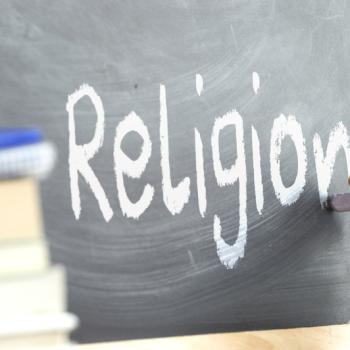How Christian were the Nazis? Not as much as many assume. The relationship between Christianity and the Nazi Party of Germany’s Third Reich was massively complicated and increasingly adversarial. Today, that relationship is often mischaracterized. Here I hope to provide a very brief, general, and simplified overview to a very complex bit of history.
The Third Reich, of course, was the government of Germany led by Adolph Hitler and his Nazi Party from 1933 to 1945. Going by what I see on social media, it appears to be widely believed that the Nazi Party was Christian. Therefore, the blame for all of the atrocities of the Nazis must fall on Christianity. Of course it must be acknowledged that the rampant antisemitism of the Nazis had centuries-old roots in the Christian institutions of Europe. But the Third Reich grew hostile to much of Christianity also. The Nazis then attempted to co-opt Christianity and make it into something very different from what it had ever been before.
What can confuse amateur historians is that the Nazi Party changed its rhetoric about Christianity after it rose to power. When it was just beginning and vying for support, the Nazi Party identified itself as a Christian party. One can find quotes of Hitler himself expressing support for Christianity. This is understandable, considering that about 95 percent of Germans in the 1920s and 1930s identified as Christian. To ingratiate themselves to voters, Hitler and other leaders of the Nazi Party issued statements that sounded very pro-Christian. But after taking over the government, the Nazi position on Christianity changed. Among other things, they demanded that all religious institutions be subservient to the state and adopt Nazi ideology. Church leaders who resisted being “nazified” were persecuted, and during Hitler’s dictatorship more than 6,000 Christian clergy were arrested. Some were sent to concentration camps; some were executed.
Note also that the full name of the Nazi party — formally, the National Socialist German Workers’ Party — was also propaganda. There was nothing “socialist” about the Nazis. Hitler, in fact, hated socialism and purged socialists from the German civil service.
The Christian Nazis and the Aryan Jesus
In 1934, at the beginning of the Third Reich, the Nazis aligned with something called the Deutsche Christen, or “German Christians.” This was a nondenominational Protestant movement that had been growing for a while. (Note that in many accounts the Deutsche Christen movement is identified as “evangelical.” It’s my understanding that in German, the word for “evangelical,” evangelisch, is a synonym for “Protestant.” The German evangelicals are not the same sub-group of Protestants as American-style evangelicals.)
The German Christians were so antisemitic that they denied the Jewish roots of Christianity. The movement repudiated the Old Testament, much of the Gospel of Matthew, and the letters in the New Testament attributed to Paul. These were considered too Jewish. Instead, Christianity was a religion of Aryans who opposed Judaism.
The ancient Aryans were a Sanskrit-speaking, nomadic people who probably originated in eastern Europe, ca. 3000 BCE. They migrated across Asia and reached India about 1900 BCE, where their sacred texts became the basis of Hinduism. The Nazis imagined the Aryans were a Nordic “master race” who originated civilization. To fully appreciate why that idea was utter nonsense, do see “Who Were the Aryans?” But the Nazis identified themselves as Aryan and co-opted the swastika, originally a symbol of benevolence, from Hinduism. According to Nazi Christianity, Jesus was not Jewish but one of the Nordic Aryans.
Nazi Christianity and the Third Reich
Originally Hitler had hoped to consolidate all German Protestant churches into one official church of the Reich. The Deutsche Christen movement did its best to make that happen. The “German Christians” were able to gain control of many Protestant churches and won over some theologians.
One such theologian, Walter Grundmann (1906–1976). published a new version of the Bible, called The Message of God (Die Botschaft Gottes). Along with eliminating the entire Old Testament, Grundmann’s editorial team flagged anything even remotely connected to Judaism, including references to Jesus as the Messiah, “the annointed,” because it’s a Hebrew word. Many of the parables and stories of miracles were deleted also, often for being too “rabbinical.” References to Jesus at the “Lamb of God” were removed, as well as the line from the Beatitudes about the blessedness of the merciful. The editors claimed there had been a “lost original” New Testament that portrayed Jesus as a White Nordic-Aryan warrior. This authentic Testament had been rewritten by Paul, who was a Jew, and by taking out all Jewish material, they claimed to be restoring the text to its original state.
The Deutsche Christen movement also supported the cult of personality that grew around Hitler. This cult of personality portrayed Hitler as (ironically) a messianic figure, the embodiment of the German people and their destiny. Only Hitler could restore the Germans to their rightful place in the world, the propaganda said. Only through Hitler could the German people become powerful again.
Hitler’s Religious Views
Adolph Hitler was raised Catholic, but by the time he was a teenager he was turning away from Catholicism. He came to have a deep antipathy to the Catholic Church. When he came to power in 1933, he favored the Protestant churches. He expressed admiration for Martin Luther, the 16th century German priest whose rebellion against Catholic doctrine began the Reformation. Hitler soon expressed solidarity with the German Christians, some of whom considered Hitler the fulfillment of the Reformation. As the Nazis took over in Germany, Catholics became targets of oppression. Hitler was determined to prevent the Catholic Church from having any political power in Germany. The Vatican, then headed by Pope Pius XI, negotiated a treaty with the Reich to protect the religious freedom of Catholics. This treaty, called the Reichskonkordat, has been an object of controversy ever since.
His admiration for Luther notwithstanding, in the last years of his life Hitler’s own religious beliefs had no connection to Christianity. Some people who knew him claimed he was an atheist, but historians today doubt that. Hitler appears to have held and believed in some concept of God, just not the Abrahamic one.
The Christian Resistance
Originally Hitler had hoped to consolidate all German Protestant churches into one official church of the Reich, modeled on the German Christians. This church was to be an arm of the Nazi Party and reflect the Nazi political agenda. A number of Protestant church leaders resisted and formed a movement called the Confessing Church. Leaders of the Confessing Church included Martin Niemöller, Karl Barth, and Dietrich Bonhoeffer.
The Confessing Church refused to accept the German Christians’ version of Christianity and remained true to traditional theology. In time the Nazi Party moved against it. Barth was able to find refuge in his native Switzerland. Niemöller was arrested in 1937 and spent the rest of the Third Reich in a series of concentration camps, but survived. You may recognize Niemöller as the author of the poem “First They Came.” Bonhoeffer, the subject of many books and a couple of major motion pictures, was executed.
The British historian Alan Bullock is credited with the seminal work describing Adolph Hitler’s religious views. In Hitler: A Study in Tyranny, Bullock wrote that Hitler came to see Christianity as a religion fit only for slaves. Bullock also wrote that by 1942, Hitler vowed to destroy the influence of all Christian churches, describing them as “the evil that is gnawing our vitals.” According to Bullock and other historical scholars, by the 1940s Hitler had decided to eliminate all Christian institutions in Germany, as soon as he had won the war.
Christians and Nazis: Postscript
As I said, this is a vast, and complex, bit of history that can’t be fully explained in one column. But to me, any claim that Hitler or the Third Reich were Christian is just wrong. The leaders of the Nazi Party held varying views on religion, but on the whole they distrusted Christian institutions and allowed them to exist only as long as they were useful. It’s also the case that many Nazis explored Norse paganism and other alternative religions.
If you want to explore this topic, along with the work of Alan Bullock cited above, here are just a few of the good books about religion in the Third Reich:
Richard Weikart , Hitler’s Religion: The Twisted Beliefs that Drove the Third Reich (Regnery History, 2016)
Matthew D. Hockenos, Then They Came for Me: Martin Niemöller, the Pastor Who Defied the Nazis (Basic Books, 2018)
Dean G. Stroud, editor, Preaching in Hitler’s Shadow: Sermons of Resistance in the Third Reich (Eerdmans, 2013)
Doris Bergen, Twisted Cross: The German Christian Movement in the Third Reich (University of North Carolina Press, 2000)
If you have more book recommendations, please add them to the comments.














